|
|
|||||||
 |
|
|
Thread Tools | Display Modes |
|
|
|
#1
|
|||
|
|||
|
Bill, I will agree and disagree with reference to your take on Hernandez. He was a very good first baseman, however, I do not know anyone who would refer to him as elite, as you did.
__________________
My new found obsession the t206! |
|
#2
|
||||
|
||||
|
Quote:
Here's a poll on Baseball Fever that Hernandez wins, taking 44% of the vote" Baseball Fever. Twenty names listed, and he's the top vote getter. And there are references in the discussion to other polls taken in other places, including sabermetric-based sites, where Keith Hernandez won. Just from my own personal discussions with baseball fans, Cardinal and Mets fans I've talked with, he's absolutely revered for his defensive play. His intensity, and his talent, just separated him from the pack. Go to Youtube, and watch the highlight films of him playing. Nothing gets by him. He's diving for balls all over the field. When somebody was dumb enough to bunt against the Mets, Hernandez would come rushing in, grab the ball, and beat the runner going to second with an absolute lightning strike. I watched him play, and he's the best I've ever seen defensively. I got to see him in the '82 World Series with the Cardinals. He did nothing with the bat in the first three or four games. But he was awesome defensively. And then we only had to win one of the last two games to win the series. And Hernandez destroyed us. In the last three games if the series, after going oh for the first four games, he was 7 for 12 with two doubles, a home run and 8 RBI. The guy's a vacuum with a glove.
__________________
Building these sets: T206, 1953 Bowman Color, 1975 Topps. Great transactions with: piedmont150, Cardboard Junkie, z28jd, t206blogcom, tinkertoeverstochance, trobba, Texxxx, marcdelpercio, t206hound, zachs, tolstoi, IronHorse 2130, AndyG09, BBT206, jtschantz, lug-nut, leaflover, Abravefan11, mpemulis, btcarfagno, BlueSky, and Frankbmd. |
|
#3
|
||||
|
||||
|
Luis Tiant, pitcher
Luis Clemente (Vega) Tiant (El Tiante) Cleveland Indians (1964-1969) Minnesota Twins (1970) Boston Red Sox (1971-1978) New York Yankees (1979-1980) Pittsburgh Pirates (1981) California Angels (1982) 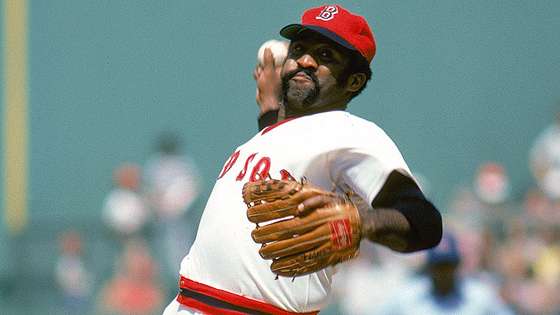  Luis Tiant started his Major League baseball career at an interesting time in baseball history. 1964 marked the beginning of the second "dead ball era", which saw a substantial decrease in runs scored, and hitting, across baseball, but especially in the American League. Some would put the beginning of this era even a year earlier in 1963, which I tend to agree with. 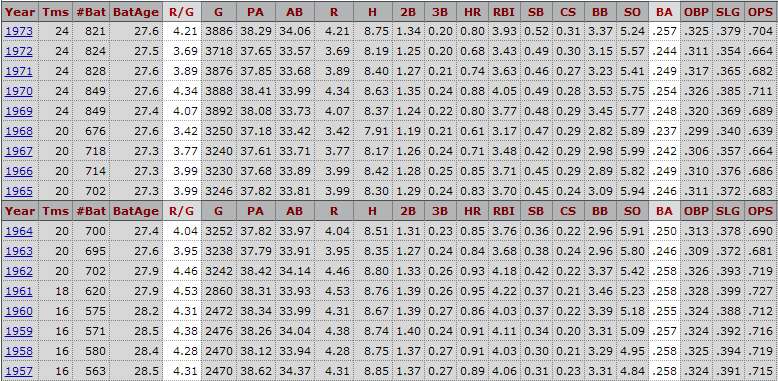 The second dead ball era, and the beginning of Luis Tiant's career Up to the 1962 season, Major League games saw an average of 4.25 runs per game or more, occasionally eclipsing 4.5 runs. In fact, the last time the Major League average dropped to below 4 runs scored per game was in 1943. But in 1963, the Major League average for runs per game dipped to 3.95, and the Major League batting average consistently ranged between .255 and .264 for more than a decade. In 1963, the Major League average dropped to .246. The numbers continued on as well below normal, reaching lows in both runs scored and league batting average in 1968, when there were only 3.42 runs scored per game, and the average Major Leaguer was hitting .237. Why these things happened would make for an interesting discussion in and of itself. But I present this information here to paint a picture of what was going on in baseball at the time Luis Tiant came up to the Majors with the Cleveland Indians. And as you all will soon see, Luis Tiant helped to lower those numbers. And at his very best, Tiant was almost unhittable. But, should Luyis Tiant have been a Hall of Famer, too? Luis Tiant, born in Marianao, La Habana, Cuba in 1940, the only son of Luis Tiant Sr. Tiant Sr was himself a great pitcher for the New York Cubans of the Negro League. Tiant's professional career started in his native Cuba, and upon the recommendation of Bobby Avila, a former All Star infielder for the Cleveland Indians who was scouting for the team in Cuba, Tiant signed with the Mexico City Tigers of the Mexican League. Tiant split his time between the two teams for the next few years, until the Cleveland Indians purchased his contract from the Tigers. Tiant flew to America, and reported to the Charleston Indians, a Class A ball affiliate of the Indians, in 1962. Over the next two years in the minors, Tiant would compile a 29-10 record with an ERA slightly under 2.50. The Majors awaited Tiant. The Indians called him up, and he made his Major League debut in spectacular fashion, throwing a complete game shutout of the New York Yankees at Yankee Stadium on July 19, 1964. He struck out 11 and gave up only 4 hits. His next start was also a complete game, this time at home against the Boston Red Sox. He gave up one run, striking out 6. Tiant was on his way. Luis Tiant, at age 23, would go 10-4 with a 2.83 ERA. He would pitch five more seasons with the Indians, including a spectacular 1968 campaign where he would go 21-9 with an American League leading 1.60 ERA, and 264 strike outs. He allowed 5.3 hits per 9 innings pitched, also best in the league. Yet Tiant, now an All Star, didn't receive a single Cy Young vote, as Denny McClain of the Tigers went 31-6 with a 1.96 ERA. Tiant would go 9-20 the next season as his ERA ballooned up to 3.71. Tiant would spend a single season with the Minnesota Twins, where he would go 7-3, before moving on the the Boston Red Sox. Over the next eight seasons, Tiant and his unique delivery would win 122 games. He would finish in the top 5 of the Cy Young voting twice, and end up sixth another. He'd have three more 20 win seasons, and be named to two more All Star teams. At the end of the 1978 season, Tiant had a career record of 204 wins against 148 losses, and a 3.16 ERA. He would play two seasons with the New York Yankees after signing as a Free Agent, going 21-17 as a Yankee. At age 40, he went to the Pittsburgh Pirates, his first time on a National League team. He started 9 games, and went 2-5. The next season, 1982, he came back to the American League as a member of the California Angels. He made 5 more starts, going 2-2, before calling it a career. At the end of the 1978 season, Tiant had 204 wins and a career 3.16 ERA. A 3.30 ERA, where he ended up at retirement, is still very good. But I think he'd have been better off with the lower ERA as far as his Hall chances go. But, like many of the players we've looked at, Luis Tiant hasn't received serious support from the BBWAA. In 1988, his first season on the ballot, his name appeared on 30.9% of the ballots. One would think that with a decent start like that, he might have a shot at getting closer to the requisite 75%, even if he ultimately felt short. For players to have a reasonably good shot at being voted in by the Veterans Committee, I feel getting a BBWAA vote above 50% is helpful, or at the least, it's indicative of a player's chances down the road. The next year, however, Tiant dropped from 30.9% to 10.5%. Why there was such a precipitous drop is a curiosity to me. In 1988, only Willie Stargell was voted in. Jim Bunning appeared on 74.2% of the ballots, and Tony Oliva was third at 47.3%. Obviously, 1989's ballot brought some tough competition. Carl Yastrzemski and Johnny Bench both made it on their first try, Gaylord Perry received 68.0%, and Bunning received 63.3%. Tiant dropped from 8th to 15th place in the voting. Let's compare Tiant against his contemporaries. What do I compare when looking at pitchers? Obviously, my old standby OPS isn't applicable here. Wins, win-loss record, etc, isn't the greatest indicator of a pitcher's effectiveness. A bad pitcher can still win with enough run support. A great pitcher can still lose with no run support. With pitchers, I like to look at the things they can control first. ERA+ pitchers have a lot of control over, but the defense behind a pitcher also comes into play. ERA + is more effective as it adjusts for the ballparks a pitcher plays his games in. It's a start. So, the first report I ran covered the period of 1964 to 1972. Pitchers who threw a minimum of 1,200 innings across these nine years which are considered the second "dead ball era". Since Tiant's career covered this entire period, and another decade beyond this, running one report over the entire period of his career would skew some of the data. Pitchers who did not throw during this era that favored pitchers (for whatever reason) would suffer comparatively. It would appear that Tiant pitched better than them when he may or may not have. Here are the results of this first report. 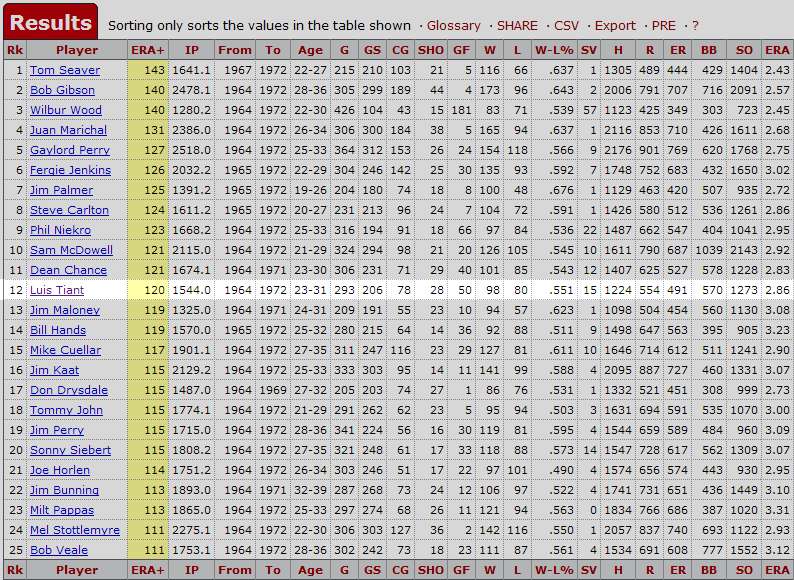 What am I seeing in this report, and other similar reports I have run, changing the years, the inning requirements, etc? Luis Tiant is staying in relatively the same place, in the top 20% of the resulting reports run. In this report, he is 12th out of 61 pitchers who attained 1,200 innings pitched in the Major Leagues between 1964 and 1972. When I open this report up to 1964 to 1982, the entirety of his career, he's 21st in ERA + of 108 pitchers that met the 1,500 innings pitched requirement. You can view the results of the report here if you so choose. What about WHIP, or walks and hits per 9 innings pitched. This is one metric a pitcher has a lot of control over. Again, the defense behind him still impacts the total, but a pitcher can control how many walks he throws, and he can have a big impact on the number of hits he gives up. So, again, 1964 to 1982, 1,500 innings pitched, and Luis Tiant is again 21st on the list. It appears that Mr. Tiant is remarkable consistent. You can read this chart as well, so should you choose. Here's an interesting stat to consider. WPA, or win probability added. This calculates how much of an impact a player had in their team's win. Over the course of a season, or several seasons, or even a career, this is a great sabermetric stat. Plays within a game affect the likelihood that team will win, and WPA will actually weigh the same play differently depending on the situation. A solo home run leading off the game is not weighed the same as a solo home run in the bottom of the ninth in a 2-2 tie. The walk off home run would contribute more to the win. The lead off home run obviously was important. Without it, there would have been no tie. But the game winning home run was definitive. So, when we look at WPA over the course of Tiant's career, we can compare the pitchers that played at the same time, under the same rules, in the same era. Those same 108 pitchers that threw 1,500 innings. Only now Tiant is 10th on the list. Instead of being in the top 20% (19.444% to be precise), he's now closer to 10% (9.259%). Here's the report if you would like to see all the pitchers in order. Notice the pitchers that have lesser WPA scores with approximately the same innings. 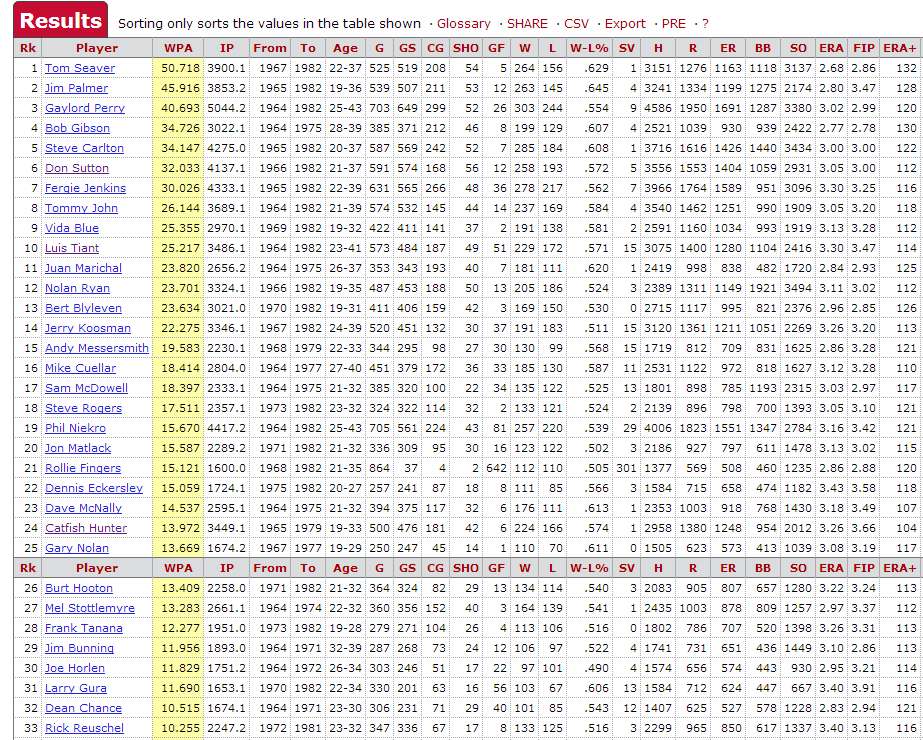 Here's a breakdown I did of Luis Tiant compared to the Hall of Fame pitchers that appeared on this list. This is innings pitched per 1 point of WPA. The math is innings pitched (whole innings only) divided by WPA. A lower number is better. Tom Seaver 76.8957 Jim Palmer 83.9141 Gaylord Perry 123.9574 Bob Gibson 87.0241 Steve Carlton 125.1940 Fergie Jenkins 144.3082 Don Sutton 129.1480 Vida Blue 117.1366 Luis Tiant 138.2400 Juan Marichal 111.5029 Nolan Ryan 140.2472 Bert Blyleven 127.8243 Phil Niekro 281.8761 Dennis Eckersley 114.4830 Rollie Fingers 105.8131 Catfish Hunter 246.8508 Jim Bunning 158.3305 Luis Tiant would be closer to the bottom of the list if they were sorted by total. But he was better than some pretty good pitchers: Catfish Hunter, Nolan Ryan, Phil Niekro, Jim Bunning. Now, I don't know the exact formula of how Win Probability Added is calculated. But it seems to me that this straight forward analysis is sound. Finally, one last metric, also from sabermetrics. Adjusted Pitching Wins (APW), which measures a starting pitcher's value in wins. Between 1964 and 1972, Tiant was ranked 9th in this metric, out of 199 pitchers with 1,000 innings pitched. The eight pitchers ahead of him are all in the Hall of Fame. 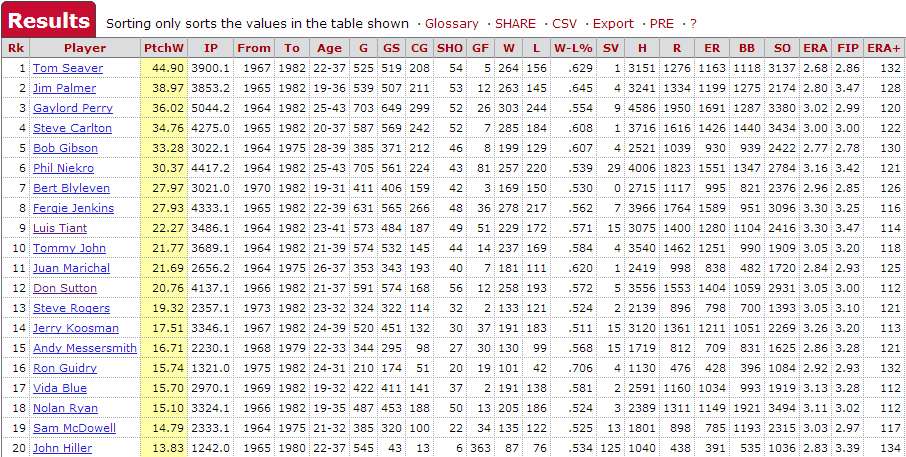 Looking now at awards, accolades, and times he led the league in primary pitching categories. Luis Tiant never won a Cy Young Award, but he certainly had some outstanding seasons, a few which would generally receive serious consideration for the Award. But remember, too, that some of his numbers are skewed somewhat by the era. Pitching ruled for a big part of his career. But, the argument could also be made that the reason pitching ruled was the direct result of the quality pitchers playing the game. No matter how pitcher friendly the second dead ball era might have been, being a starter, and giving up under 2 earned runs a start is special. And Tiant did that twice. Tiant's 1.60 ERA in 1968 was the second best individual season ERA during the period of 1964 to 1982 (minimum 162 innings pitched). And his 1.91 ERA in the 1972 season was the 12th best during this period. Luis Tiant was named to the All Star team only three times (1968, 1974, 1976). He finished in the top 5 for the American League Cy Young twice, and another time, he finished sixth. In 1968, though he did not receive a single Cy Young vote, he finished fifth in the MVP vote. Though he never led the league in wins, he won 22 games once, 21 games twice, and 20 once. In 1975, he won 18. In all, he had 13 seasons of double digit wins. In 1969, his 20 losses led the American League, a year after winning 21 games. He led the league in ERA twice. His 5.3 hits allowed per 9 innings in 1968 led the league, as did his 9.2 strikeouts per 9 innings in 1967. In 1966 and 1968 he led the American League in shutouts. Since the advent of Sabermetrics, Tiant has found himself leading the league in statistics he didn't know existed. In 1968 and 1972, he led the AL in ERA +. He lead the AL in FIP, fielding independent pitching, in 1968, and in WHIP in 1973. What about the Hall of Fame Statistics? The two players most similar to Luis Tiant, Catfish Hunter and Jim Bunning, are both Hall of Famers. The sixth most similar pitcher is another Hall of Famer, Don Drysdale. He falls short in both the black ink and gray ink statistics. His black ink score is 13. A likely Hall of Famer has a 40 black ink score. The average gray ink score for a Hall of Famer is 185. Tiant's is 112. But the two other scores, Tiant is very close to Hall of Fame level. The Hall of Fame Monitor lists a score of 100 as being a likely Hall of Fame inductee. Tiant has a score of 97. And finally, the Hall of Fame Standard has the average Hall of Famer scoring a 50, and Tiant is fairly close with a 41. The Jaffee WAR scoring system (JAWS) ranks Tiant as the 51st best starting pitcher of all-time. Tiant's 66.7 WAR is slightly below the WAR of an average Hall of Fame pitcher, 73.4. Personally, I think Luis Tiant absolutely deserves another look by the Veterans Committee. The clincher for me was the adjusted pitching wins metric. When the only players that had a higher APW over that 19 year period he played were Hall of Famers, he's in pretty rare company. Let's open up the discussion on Luis Tiant. Do pitchers still need to have 300 wins, or 3,000 strikeouts to get in as a starter? Do pitchers from past eras need to get one of these to get into Cooperstown? There are pitchers who, obviously, are exceptions to this. Koufax is one, but Koufax was on a whole other level at the end of his career. Tiant was great in his prime. But was he one of the best pitchers of his era? Would being one of the best be enough? His 162 game averages: 15-11, 3.30 ERA. 155 K, 71 BB in 224 IP. 114 ERA + and a 1.199 WHIP. 7.9 hits, 2.8 walks and 6.2 K per 9 IP. Let's see some Luis Tiant cards, photos, etc, too.
__________________
Building these sets: T206, 1953 Bowman Color, 1975 Topps. Great transactions with: piedmont150, Cardboard Junkie, z28jd, t206blogcom, tinkertoeverstochance, trobba, Texxxx, marcdelpercio, t206hound, zachs, tolstoi, IronHorse 2130, AndyG09, BBT206, jtschantz, lug-nut, leaflover, Abravefan11, mpemulis, btcarfagno, BlueSky, and Frankbmd. |
|
#4
|
||||
|
||||
|
Hmmm. I don't remember Tiant as an 81 Buc. Good stuff, not a HOFer though.
Last edited by Mountaineer1999; 09-16-2014 at 07:37 PM. |
|
#5
|
||||
|
||||
|
Another wonderful job, Bill!
I am more sure that Minoso is a HOFer than Tiant, but, as you said, he deserves strong consideration. While on that island, how about Tony Oliva...I think his injuries cost him any serious consideration, but he would also be close. I also noticed a couple of names high on your Dwight Evans-related tables: Reggie Smith and Jack Clark While I am sure Clark is no candidate, how bad was Smith in the field?
__________________
. "A life is not important except in the impact it has on others lives" - Jackie Robinson If you have a chance to make life better for others and fail to do so, you are wasting your time on this earth.- Roberto Clemente |
|
#6
|
||||
|
||||
|
Thank you, Raymond.
Jack Clark was a nice player. He provided solid offense throughout his career, and it seemed to me that he always came up with the clutch hit when his team needed it. But when I look at his career stats, he was in reality quite average with runners in scoring position, or in high leverage situations. Perhaps his reputation as a big time clutch hitter was overblown. The thing that's really strange about Clark is his career walk rate, and its effect on his OBP. Between 1975 and 1986, he got on base at about a .360 clip. That's pretty good. When you add in his 20-25 home runs every season, he made a nice player. But he seemed to figure something out in 1984. He only had 203 at bats, but he walked 43 times. He hit .320 in that shortened season, and his OBP was .434, which was highly irregular for Clark. For the next two seasons, his OBP dipped back between .362 and .392. But then in 1987, he became an on base machine at age 31. He walked 90 times in 1982, but he had 659 plate appearances. Well, in 1987, seemingly out of nowhere, he walked 136 times. Not only did his walks spike, but so did his strikeouts (139 Ks, 95 prior career high), and his home runs jumped up to 35. He had a .459 OBP and a .597 SLG for a spectacular 1.055 OPS, and a 176 OPS +. He would move over to the American League, and the Yankees the next season. He still walked 113 times. The next two seasons, he went back to the NL and played with the Padres, where he again led the NL in walks each season, with 132 in 1989 and 104 in 115 games in 1990. He played two more years, both with Boston, before retiring. He had 96 walks the first season in 140 games, and 56 walks in 81 games his final season. He he ended up walking 1,262 times in his career. I don't know much about Reggie Smith's defensive abilities. He spent his first 8 seasons with the Boston Red Sox, and won one Gold Glove there in 1968. He had a 3.4 dWAR in total in those 8 seasons, his best being a 2.1 1970. He has a 64.5 career WAR, made up almost entirely from offensive contribution. His dWAR for his career ended up at 2.6. I don't know all that much about him, just what he did while with the Dodgers for the most part. He had back to back top 5 MVP finishes in 1977 and 1978, his best season being in 1977 when he had a 1.003 OPS, and a 168 OPS + which led the National League. He also led the league with a .427 OBP. He had a really nice career. 300 + home runs, 2,000 hits, and an .855 OPS. He led the AL in doubles in 1968 and 1971, with 37 and 33, respectively. Hard to imagine somebody leading the league with 33 doubles now, isn't it? Quote:
__________________
Building these sets: T206, 1953 Bowman Color, 1975 Topps. Great transactions with: piedmont150, Cardboard Junkie, z28jd, t206blogcom, tinkertoeverstochance, trobba, Texxxx, marcdelpercio, t206hound, zachs, tolstoi, IronHorse 2130, AndyG09, BBT206, jtschantz, lug-nut, leaflover, Abravefan11, mpemulis, btcarfagno, BlueSky, and Frankbmd. |
|
#7
|
|||
|
|||
|
I think Tiant was another player whose chances suffered from a lack of a really solid relationship with the press. He was fairly open with them, nowhere near as quiet as Evans or avoiding them like Rice and some of the other Sox players. But at times he could be somewhat hard to understand which didn't make for "good" interviews.
If HOF voting was based on how the local fans perceive a player he'd be in already. I haven't met him myself, but know a couple people who have and by all accounts he's a fun guy. Another thing that might have hurt his chances was that like many of the sox pitchers in the 70's he was a bit spotty. Sometimes brilliant, sometimes awful. You never really knew what you were getting. And he got a ton of run support for the era. Lee, Wright, Tiant, all were a bit unpredictable. Eckersley was a bit more stable, and Torrez was predictable - He'd get to a certain part of the game and simply disintegrate, and Zimmer never seemed to figure that out. It's interesting how different eras compare. Today, a pitcher that reliably wins in the mid teens with a decent ERA is doing very well. Steve B |
|
#8
|
|||
|
|||
|
Quote:
__________________
My new found obsession the t206! |
|
#9
|
||||
|
||||
|
When I was referring to Hernandez as an elite first baseman, I meant his defensive ability was elite only. He was a very good hitter who had some outstanding seasons. But I would never call Hernandez elite offensively, especially for what the majority of first basemen were expected to provide offensively. Hernandez didn't provide enough power to be considered an elite offensive first baseman. But he was so good defensively, I think taken as a whole, he deserves another look for the Hall. I'd rate his defense a 10, and his offense about a 6, a 6.5 or closer to a 7 in his MVP season.
Quote:
__________________
Building these sets: T206, 1953 Bowman Color, 1975 Topps. Great transactions with: piedmont150, Cardboard Junkie, z28jd, t206blogcom, tinkertoeverstochance, trobba, Texxxx, marcdelpercio, t206hound, zachs, tolstoi, IronHorse 2130, AndyG09, BBT206, jtschantz, lug-nut, leaflover, Abravefan11, mpemulis, btcarfagno, BlueSky, and Frankbmd. |
 |
|
|
 Similar Threads
Similar Threads
|
||||
| Thread | Thread Starter | Forum | Replies | Last Post |
| Evidence of trimming? | bobbvc | Net54baseball Vintage (WWII & Older) Baseball Cards & New Member Introductions | 7 | 04-05-2014 10:44 PM |
| Cooperstown victim of Cooperstown Forger! New article | okmaybent@aol.com | Net54baseball Vintage (WWII & Older) Baseball Cards & New Member Introductions | 0 | 05-17-2012 04:11 PM |
| SABR "2010 Overlooked 19C BB Legend" Vote Results | Joe_G. | Net54baseball Vintage (WWII & Older) Baseball Cards & New Member Introductions | 21 | 08-15-2010 03:19 PM |
| Have you seen the 1890 NY Players League team photo this drawing is based on? | orator1 | Net54baseball Vintage (WWII & Older) Baseball Cards & New Member Introductions | 4 | 07-01-2009 12:41 PM |
| The Evidence as Promised | Archive | Net54baseball Vintage (WWII & Older) Baseball Cards & New Member Introductions | 7 | 05-01-2008 08:02 PM |